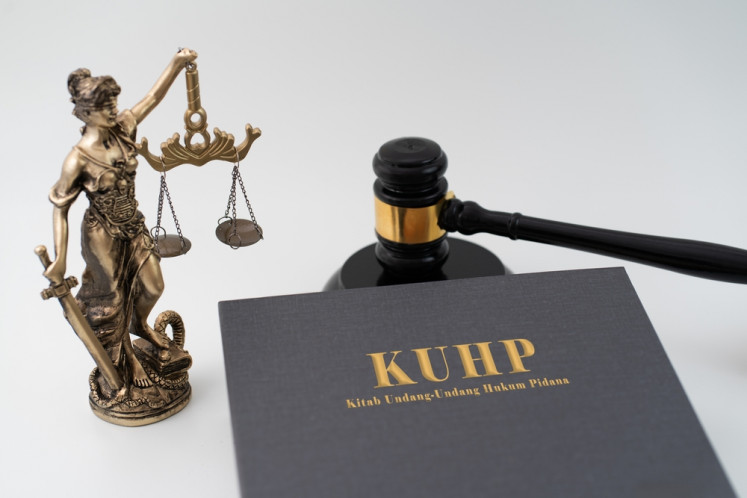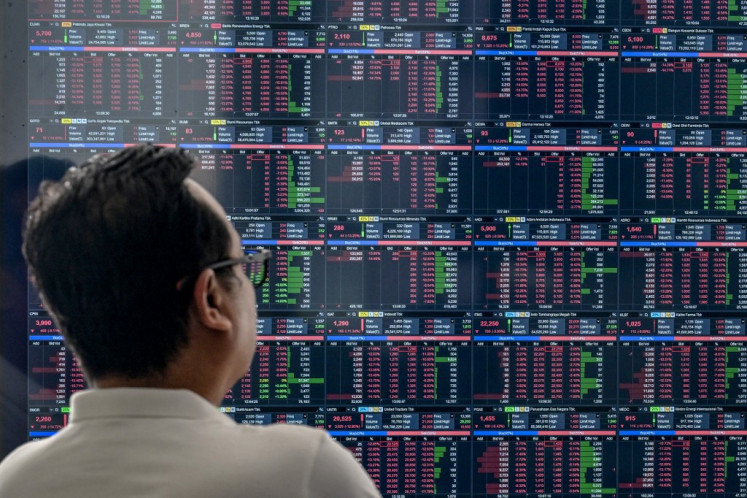Popular Reads
Top Results
Can't find what you're looking for?
View all search resultsPopular Reads
Top Results
Can't find what you're looking for?
View all search resultsBuilding with green bricks
All natural: The Green School in Bali features bamboo construction engineered into a more modern look
Change text size
Gift Premium Articles
to Anyone
All natural: The Green School in Bali features bamboo construction engineered into a more modern look. JP/ Zul Trio Anggono
Steel or stone? Bamboo or brick? Concrete or composites? A wiser choice of construction materials could go a long way to transforming our cities into “greener” urban jungles.
An environmentally friendly building is not only about choice of site and the play of the layout. The actual materials that are laid down for the foundations, frames, walls, roof and cladding determine how green a building really is.
To date, our vocabulary on building materials has been limited to bricks, cement, timber and glass with steel occasionally popping up when needed.
But experts agree that so much more can be done to make the already widely used materials greener or to maximize the potential of currently underused ones.
Bamboo is among the latter. The pipe-like plant that can grow and be harvested faster than conventional wood is earning the label of 21th-century building material.
“In just four or five years, bamboo stems are old enough to serve as solid framing. And every year afterwards it can still be harvested,” said Eko Prawoto, a leading architect who since 2000 has tested various types of bamboo construction.
“In a way, bamboo is more renewable than timber.”
While architects in Japan and Germany have started to explore the potential of the plant for the construction industry, not many in Indonesia are willing to take the same path that Eko trod.
“Bamboo has been utilized here for centuries and it has a social aspect, quite apart from the fact that it is a potential green building material,” he said. “Its elasticity makes it suitable for buildings in earthquake-prone areas like Indonesia and it’s a labor-intensive material.”
Because of its hollow cylindrical-shaped segments, bamboo is lighter than steel but can almost match its traction coefficient. It is also stronger than concrete.
Yet despite Indonesia’s abundance of the natural material, bamboo is still viewed as being a building material for the poor. Mention building with bamboo, and the image that most likely first comes to mind is of a makeshift shack in a rural village.
Indonesia is home to some 60 species of bamboo, on a total of around 320 hectares of plantation with an annual production of 726,000 tons, according to Forestry Ministry data.
Most bamboo production and trade is conducted by small and medium enterprises, ranging from traditional bamboo wall weavers to small workshops developing more modern bamboo product manufacturing processes.
Yogyakarta’s Gadjah Mada University researcher Morisco has developed more solid bamboo jointing by combining the woody stalks with steel plates and bolts and filling the hollow segments at the joints with cement.
The result is a roof frame that is cheaper than that made of conventional wood, less prone to termites as the bamboo is pre-treated and can hold up even in the event of earthquakes.
Morisco’s laboratory has also come up with laminated bamboo where the stalks are cut and flattened into planks similar to wooden ones. These “planks” can then be further processed into wall
cladding, doors, window sills and furniture.
And, as Eko pointed out, with plaster on both sides, a traditional bamboo wall is as sturdy as one made of brick.
A class of life: Visitors of the Bali Green School give a try at weaving roof covering from dried tall grass. JP/Zul Trio Anggono
Bamboo is not the only green material. Several researchers have also tried modifying the composition of conventional bricks by utilizing waste.
Yogyakarta’s Islamic State University researcher Fajriyanto adds sludge from paper factories, plastic waste and coir into a composite that could serve as building panels, which would have an elasticity suitable for construction in earthquake-prone areas.
Meanwhile, a researcher at Bandung’s Ceramic Center, Nuryanto, is currently developing permeable ceramic paving, a type of ground cover that would better let water seep into the soil than the currently available concrete blocks do.
Once the prototype is completed and industry gets involved to mass produce these paving blocks, urbanites will be able to pave their car ports while still letting water flow underground, therefore both adding to groundwater reserves and preventing flooding.
“It is made of feldspathic materials which are more porous than concrete,” Nuryanto said. “Mixed with coloring, it can still be aesthetically pleasing as well as environmentally friendly.”
For the current planned production, the feldspar, or tectosilicate minerals, can be found in Banjarnegara in Central Java and Pangaribuan in North Sumatra.
Adding waste material to composites is actually not a new thing in the building material industry.
Researchers have long suggested the addition of fly ash, the waste generated from burning coal, into concrete mix.
Most recently, researcher Puti Farida Marzuki has also suggested replacing Portland cement with a mixture of hydraulic lime with fly ash when building small houses.
“Small houses such as those built by the government public housing program don’t need the strength
of Portland cement. It’s too expensive and needs a lot of energy resources in the manufacturing process,” Puti said.
By mixing calcium hydroxide with cement-like pozzolan aggregate in a simple churning sill, locals can produce their own affordable alternative to Portland cement.
Many have tried coming up with more environmentally friendly building materials, but unfortunately, it is not that easy to tempt industries to start mass producing these alternatives.
So far, the research and development of such products has mostly been done independently of the building materials industry.
And apparently, there are no incentives available either to link inventors and producers.
For this, Indonesia might want to learn from its neighbor Singapore, which currently provides incentives for building material producers that develop greener products.
“We want to further develop our subsidy scheme into one where industries can submit an ad hoc proposal so that the support can be channeled when needed,” Singapore’s Building and Construction Authority research division director Ang Kian Seng said.
“But, we only want to support those with a sound proposal. Green construction does not need to be expensive,” he added.
Nevertheless, even without such a scheme, some local building material manufacturers have increased their own research and development efforts to serve the market with a greener product.
“The problem is that sometimes architects who are supposed to choose those greener building materials are not aware that they exist,” said Naning Adiwoso, head of Green Building Council Indonesia.
Naning pointed out that locally made products such as water-based paint, nano-finished ceramics or biofil septic tanks were already available for those looking for more environmentally friendly construction materials.
But, then again it’s always a matter of choice. Steel or bamboo? Concrete or permeable paving?











